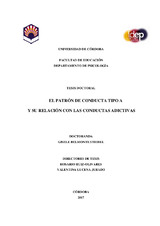El patrón de conducta tipo A y su relación con las conductas adictivas
Autor
Steibel, Gisele Belmonte
Director/es
Ruiz Olivares, RosarioLucena Jurado, Valentina
Editor
Universidad de Córdoba, UCOPressFecha
2017Materia
Patrón de conducta tipo BSustancias adictivas
Adicciones conductuales sin sustancia
Jóvenes
Type B Behavior Pattern
Addictive substances
Behavioral addictions without substance
Young people
METS:
Mostrar el registro METSPREMIS:
Mostrar el registro PREMISMetadatos
Mostrar el registro completo del ítemResumen
El objetivo principal de esta investigación fue evaluar la posible relación entre el patrón de
conducta tipo A (PCTA) en jóvenes de la provincia de Córdoba (España) con la posibilidad de
presentar adicciones. Se evaluaron adicciones con sustancias, como tabaco, alcohol, cannabis,
tranquilizantes, cocaína y alucinógenos, y adicciones conductuales, como uso abusivo de
Internet, juego, compras y teléfono móvil. Se aplicó un diseño prospectivo expost-facto y un
cuestionario elaborado ad hoc, además de otros cuestionarios complementares, como el Test de
adicción a las compras, el Test de adicción a Internet de Echeburúa (2003), el Cuestionario
Breve de Juego Patológico de Fernández-Montalvo, Echeburúa y Baéz (1997) y algunos ítems
sobre el uso del teléfono móvil y el cuestionario de PCTA de Jenkins (1992). Se recogió
información de 3815 jóvenes de la provincia de Córdoba (España), con un rango de edad entre
los 18 y 29 años. Los resultados revelaron que las diferentes dimensiones del JASE-H
(impaciencia, hostilidad, competitividad y sobrecarga laboral) en los jóvenes estudiados están
todas significativamente relacionadas al PCTA (p<0,05). Esos jóvenes manifiestan ser los que
más consumen tabaco, alcohol, cannabis, tranquilizantes, cocaína y alucinógenos, además de
ser los que más compran, juegan, se conectan a Internet y usan el móvil. Se ha verificado
mayor riesgo de los jóvenes con PCTA presentar ciertas adicciones que los jóvenes con PCTB.
Para poder incluir en el análisis a la mayoría de los participantes se optó por realizar un análisis
de Clúster a partir de las variables de la personalidad que caracterizan el PCTA: impaciencia,
hostilidad, competitividad y sobrecarga laboral. Se observó que los rasgos del PCTA se
correlacionan positivamente con el mayor consumo de sustancias adictivas y con adicciones
conductuales, con un mayor riesgo de desarrollar un consumo problemático o um transtorno
adictivo que los PCTB. Investigar sobre qué variables influye en el inicio y mantenimiento del
consumo de sustancias y/o conductas adictivas contribuirá en la construcción de mejores
estrategias de prevención y de intervención en población general. The main objective of this research was to evaluate the possible correlation between Type A
Behavior Pattern (PCTA) among young people of the province of Cordoba (Spain) with the
possibility of presenting addictions. We evaluate addictions with substances, such as tobacco,
alcohol, cannabis, tranquilizers, cocaine, and hallucinogens. We also evaluate behavioral
addictions, such as abusive use of the Internet, gambling, shopping, and mobile phone. A
prospective ex-post-facto design and an ad hoc questionnaire were applied, in addition to other
complementary questionnaires, such as the Addiction to Shopping Test, the Internet Addiction
Test of Echeburúa (2003), the Brief Questionnaire on Pathological Gambling of Fernández-
Montalvo, Echeburúa and Baéz (1997), and some items on mobile phone use, and the PCTA
Questionnaire of Jenkins (1992). Data were collected from 3815 young people from the
province of Córdoba (Spain) in a range of age between 18 and 29 years old. The results
revealed that the different dimensions of JASE-H (impatience, hostility, competitiveness and
labor overload) in the studied young people are all significantly related to the PCTA (p <0.05).
This PCTA people showed the highest consumption of tobacco, alcohol, cannabis,
tranquilizers, cocaine and hallucinogens. In addition, they buy, play, connect to the Internet and
use the mobile more than others. We verified a greater risk of young people with PCTA
presenting certain addictions than young people with PCTB. In order to include most of the
participants in the analysis, we opted for a Cluster analysis based on the personality variables
that characterize the PCTA: impatience, hostility, competitiveness and labor overload. We
found that the PCTA traits correlate positively with increased consumption of addictive
substances and with behavioral addictions, leading to a greater risk of young people with PCTA
developing problematic consumption or an addictive disorder than those with PCTB. We
consider that research on which variables influence the onset and maintenance of substance use
or addictive behaviors will contribute to the construction of better prevention and intervention
strategies in the general population.

